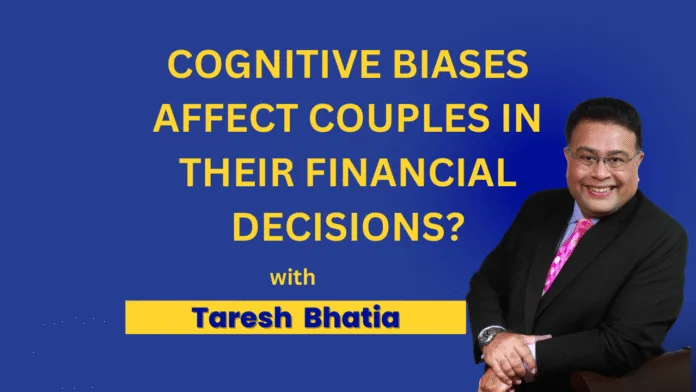Introduction: The Invisible Money Traps Couples Fall Into
As a CERTIFIED FINANCIAL PLANNER™ and a Coach at The Richness Academy, I’ve worked closely with hundreds of Indian couples over the past 37 years. And one pattern keeps repeating — the real danger in money decisions doesn’t always come from lack of income or investments… It comes from how we think.
I’m talking about cognitive biases — those silent, automatic errors in judgment that quietly hijack our decision-making. These aren’t “flaws” in intelligence. In fact, many smart, high-earning couples fall prey to them without realizing it.
Today, I’ll walk you through the 13 most common cognitive biases that affect couples — and how they distort everything from joint investments to everyday spending. More importantly, I’ll share how to identify and overcome them using the tools from my Couple Finance Formula™.
⸻
1. Confirmation Bias: “See, I told you so!”

We seek out evidence that confirms what we already believe.
I’ve seen this bias play out when one spouse says, “Mutual funds are risky,” and only watches YouTube videos that agree with them. Meanwhile, the other wants to invest but feels discouraged.
How it affects couples:
• Couples argue over whether to invest in stocks, gold, or property.
• They only seek articles and opinions that validate their side.
What to do:
Assign one partner to play “devil’s advocate.” Every month, pick one financial belief and try to disprove it together. You’ll be surprised at how your joint money mindset shifts!
⸻
2. Anchoring Bias: “Let’s stick to ₹50,000 — it’s always been our budget.”
We get stuck on the first number we hear — even if it’s irrelevant.
I once coached a couple where the husband anchored their vacation budget at ₹50,000 — just because that’s what they’d spent five years ago. Even though they could afford more, they short-changed themselves out of fear.
How it affects couples:
• Investment amounts stay fixed, despite salary increases.
• They undervalue insurance or financial advice by anchoring to old fees.
What to do:
Always benchmark using fresh, current data. Use your joint income percentage, not old habits.
⸻
3. Availability Heuristic: “My cousin lost money in crypto, we better stay away!”

We judge risks based on what’s fresh in our memory.
After hearing a news story about a real estate scam, a couple cancelled a property deal — even though it was legally vetted and safe.
How it affects couples:
• Decisions based on viral stories or relative’s failures.
• Avoiding opportunities because of recent negative events.
What to do:
Ask: “Is this statistically common or just memorable?” Base choices on real trends, not one-off cases.
⸻
4. Sunk Cost Fallacy: “We’ve already put ₹2 lakhs into this flat, let’s just finish it.”
We irrationally stick with bad decisions because we’ve already invested.
I’ve had couples continue with a poor SIP or toxic insurance ULIP just because they’ve “already paid so much into it.”
How it affects couples:
• Continuing EMIs on depreciating assets.
• Avoiding change due to guilt over sunk costs.
What to do:
Ask: “Would I buy this today?” If not, don’t throw good money after bad.
⸻
5. Halo Effect: “She’s so smart, she must be right about the FD.”
We let one positive trait bias all decisions.
One spouse may blindly trust the other because “he’s an MBA” or “she’s better at numbers.”
How it affects couples:
• One partner dominates all decisions.
• Overconfidence from one skews logic for both.
What to do:
Don’t mix emotional traits with financial logic. Even if your spouse is brilliant, still double-check the maths.
⸻
6. Recency Bias: “This month’s bonus means we’re doing great!”

Recent events cloud our long-term judgment.
After a strong market rally, many couples increase SIPs or even book luxury vacations — forgetting that market cycles go both ways.
How it affects couples:
• Overreacting to salary hikes or short-term losses.
• Making major purchases based on one good month.
What to do:
Always take a long-view. Use 3-year or 5-year average income to decide.
⸻
7. Self-Serving Bias: “We made a smart move buying that plot!” (But forget the failed ELSS fund)
We take credit for wins and blame others for losses.
I remember a couple praising their car purchase decision — but blaming their mutual fund agent for portfolio losses.
How it affects couples:
• No accountability for failed decisions.
• Blaming market, agents, or each other.
What to do:
Review wins and losses together each quarter. Accept both sides equally. Growth comes from ownership.
⸻
8. Bandwagon Effect: “Everyone’s buying gold, we should too!”

We follow the crowd, even without thinking.
During a trending IPO, several couples I know rushed to apply — without understanding the company’s fundamentals.
How it affects couples:
• Copying neighbors, relatives, or social media without research.
• Joining the real estate frenzy without checking personal readiness.
What to do:
Ask: “Would we still choose this if no one else did?” Take a pause. Decide based on your goals, not society’s noise.
⸻
9. Dunning-Kruger Effect: “We watched a video — we can do this ourselves!”
Incompetent people think they know more than they do.
One couple cancelled their financial plan, thinking they could “DIY it” after watching two YouTube videos on retirement.
How it affects couples:
• Skipping expert advice.
• Making uninformed high-risk bets (especially in crypto, stocks).
What to do:
Confidence ≠ competence. Learn together — but also seek feedback from professionals.
⸻
10. Framing Effect: “Investing ₹5,000 sounds better than saving 10%.”

How something is worded affects how we feel about it.
When I tell couples “save 20% of income,” it feels overwhelming. But when I say “₹10,000 per month into SIPs,” they say yes.
How it affects couples:
• Reacting differently to the same financial data.
• Conflicts over “how” something is communicated.
What to do:
Reframe in multiple ways. Run scenarios with actual rupee figures, percentages, and visuals.
⸻
11. Optimism Bias: “It’ll all work out, na!”
We underestimate future risks.
This bias especially hits newly married couples who believe “we don’t need insurance or wills yet.”
How it affects couples:
• Ignoring emergency funds.
• Delaying term insurance or estate planning.
What to do:
Plan for the worst, not just the best. Include contingency buffers in your Couple Finance Plan.
⸻
12. Negativity Bias: “What if we lose everything?”

We give more weight to negative possibilities.
After a bad market year, some couples stop investing altogether — losing out on long-term wealth.
How it affects couples:
• Fear-driven decisions after a bad experience.
• Over-prioritising low-yield safe instruments.
What to do:
Balance optimism with realism. Keep a “Win-Loss Journal” of past decisions to maintain perspective.
⸻
13. Endowment Effect: “But this policy is MINE!”
We overvalue what we already own.
Many couples continue old endowment policies or LIC schemes — even when better options exist — just because they already bought them.
How it affects couples:
• Attachment to legacy plans.
• Resistance to switching despite low returns.
What to do:
Ask: “Would I still buy this today?” Detach from ego, focus on performance.
Final Thoughts: Awareness Leads to Financial Freedom
Understanding these 13 biases is like lifting a fog. Once couples start recognizing them, they begin making clearer, calmer, more united money decisions.
At The Richness Academy, this forms a core part of our Couple Finance Formula™ — not just planning numbers, but training your brain to make wiser choices together.
Organised Framework for Couples to Overcome Cognitive Biases in Financial Decisions
1. Why Would These Biases Keep Couples From Progressing in Their Financial Lives?
Cognitive biases are like invisible ropes tied around a couple’s financial dreams. While income may increase and investments may grow, these mental shortcuts silently stall progress.
Take the case of Shruti and Arvind, a dual-income couple from Pune. Despite earning over ₹40 lakhs annually, they found themselves arguing over SIPs, delaying term insurance, and skipping budgeting conversations altogether. What was holding them back? As I diagnosed during one of our coaching sessions, they were trapped in multiple biases — the Endowment Effect (“We already have this policy, let’s continue it”), and Confirmation Bias (“We’ve always done it this way”).
Practical Lesson:
Before setting any new financial goal, couples must reflect:
“Is this belief helping us progress or is it just a mental shortcut from the past?”
Biases hinder wealth not because of lack of action, but because of repetitive wrong action. It’s like running on a treadmill and expecting to reach Goa.
2. How Can Some Biases Negatively Affect Couples?
Let’s explore three common ways biases harm financial relationships:
• Resentment and Conflicts: Confirmation Bias and Anchoring Bias often lead one partner to dominate decision-making. The other feels unheard. I recall a couple where the husband insisted on continuing an LIC policy just because his father had always invested in it. The wife, who understood mutual funds, felt disrespected.
• Missed Opportunities: The Availability Heuristic can prevent couples from entering the stock market. “My uncle lost money in shares!” becomes the one lens through which all equity investing is viewed.
• Inaction During Crisis: Negativity Bias leads couples to freeze during market downturns. One couple withdrew all their equity funds in 2020 fearing a market crash, locking in losses and missing the bounce-back.
Practical Lesson:
Biases are not just internal — they spill into the relationship. Naming them openly allows couples to fight the bias, not each other.
3. How to Identify That a Bias is Affecting a Couple’s Financial Decisions?
The first step is awareness. But how?
Here are 3 signs a cognitive bias is at play:
• One partner says, “We’ve always done it this way,” but can’t explain why.
• Financial decisions are based on stories (“My cousin lost money in crypto”) instead of data.
• Important plans (retirement, kids’ education, estate) are being delayed repeatedly.
Take Komal and Manish, who postponed buying term insurance for years. Why? Optimism Bias — “We’re young and healthy!” After Komal’s sudden illness, the regret was visible.
Practical Lesson:
Sit down once a quarter and reflect:
“Which recent decision of ours was based on fear, habit, or hearsay?”
Awareness defuses the bias’s hidden power.
4. What is the Process to Ride Over Biases When They’re Not Helping?
Once identified, biases must be neutralized like toxins. Here’s a 3-step process I teach in my Couple Finance Formula™ course:
- Name the Bias
Start by labeling the pattern: “Is this Anchoring?” “Are we just following the crowd?” - Reframe the Decision
Instead of asking, “Can we afford this?” try “Does this align with our long-term goals?” or “Would we make this decision today if we hadn’t already invested?” - Check with a Third Eye
Use a trusted advisor or a financial mentor to provide an external, unbiased view.
Anecdote:
Rahul and Megha were overinvested in their company stock. I asked them:
“If this wasn’t your company, would you still keep 70% of your net worth in it?”
That broke their Anchoring instantly.
Practical Lesson:
Every couple needs a regular “bias detox” — a day every quarter where all assumptions are challenged.
5. What Should Couples Do to Overcome These Biases and Make Better Money Decisions?
Here are four actionable rituals for couples:
• Bias Naming Night: Once a month, over dinner, name one decision where bias crept in.
• Switch Roles: Alternate who leads the financial conversation each month.
• Vision-Based Decisions: Always start big purchases with a shared goal, not impulse.
• The “Would You Still?” Test: Apply this to every old investment.
Anecdote:
Neha and Abhishek were stuck with five ULIPs from before they met. They did the “Would you still buy this today?” exercise. Answer? A loud “No!” They surrendered three and redirected funds into mutual funds.
Practical Lesson:
Make anti-bias habits part of your financial rituals. The goal isn’t perfection. It’s awareness with action.
6. How to Use Some Biases Positively and Turn Them Into Financial Strengths?
Yes, not all biases are bad. Some can be turned into tools.
• Optimism Bias helps couples dream bigger and invest aggressively when young.
• Endowment Effect can build ownership and responsibility in joint assets.
• Anchoring Bias can anchor a minimum savings amount — like “We always save ₹25,000 no matter what.”
Anecdote:
I helped one couple use the Halo Effect to reinforce positive habits. They admired a financially fit couple in their friend circle. We created a ritual where they mirrored one good habit from them monthly. Soon, they were budgeting, investing, and even talking money weekly.
Practical Lesson:
Once couples tame their biases, they can train them to serve their goals. That’s not just financial freedom — that’s financial wisdom.
Final Summary: Mastering the Mind for Money Harmony
The biggest mistake couples make isn’t poor investing or spending — it’s thinking they’re thinking clearly.
Every one of us, regardless of education or profession, is vulnerable to these 13 biases. The only solution is awareness, communication, and joint reflection.
At The Richness Academy, I help couples move from bias to clarity using visual tools, journaling, and money conversations that stick. When you align your brain with your goals, the money follows.
Ready to uncover the hidden mental blocks in your financial life?
Join my live webinar — Couple Finance Formula™ — where I teach you how to break these cognitive traps and make money decisions that are calm, clear, and united.
Register FREE now: www.CoupleFinanceFormula.in
Taresh Bhatia, CFP®
CERTIFIED FINANCIAL PLANNER™
Founder – The Richness Academy
WhatsApp/Call: Click to Message
Email: taresh@tareshbhatia.com
Website: www.tareshbhatia.com
The author of this article, Taresh Bhatia, is a Certified Financial Planner® and advocate for female empowerment. For more information and personalized financial guidance, please contact taresh@tareshbhatia.com
He has authored an Amazon best seller-“The Richness Principles”. He is the Coach and founder of The Richness Academy, an online coaching courses forum. This article serves educational purposes only and does not constitute financial advice. Consultation with a qualified financial professional is recommended before making any investment decisions. An educational purpose article only and not any advice whatsoever.
©️2025: All Rights Reserved. Taresh Bhatia. Certified Financial Planner®
Subscribe Now for Upcoming Blogs!
[convertkit form=6555951]
📢 Join free live webinar —
Couple Finance Formula™ Register here




